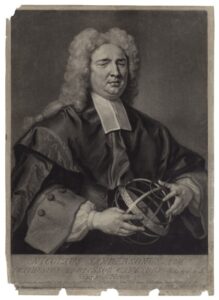Nicholas Saunderson
Nicholas Saunderson: The blind Lucasian Professor from Thurlstone
by Abeer Al-Ghouleh
Nicholas Saunderson was a mathematician who transcended his disability, to become the fourth Lucasian professor at Cambridge University: a prestigious post that has been held by scientists such as Isaac Newton and Stephen Hawking. As his story shows, his sharp mind and natural sense of curiosity always helped Saunderson to channel setbacks into opportunities and persistently find unorthodox ways to pursue his education despite being blind at the age of one in an era before Braille.

Fig 1: Nicholas Saunderson. Source: NPG D27603; Nicholas Saunderson – Portrait – National Portrait Gallery
Saunderson was born at Thurlstone, Yorkshire in January 1683. His father was a Yorkshireman who made a living as an exciseman. When Saunderson was one year old, he caught smallpox and, due to abscesses forming in his eyes, he lost both his sight and his eyes.
Although he was born at a time with no established methods to facilitate education for the blind, he nevertheless started by teaching himself how to read by running his fingers over the surface of gravestones. He was able also to learn arithmetic with the assistance of his father, as he was working as an excise man and Saunderson used to help him with his work.
When he could not write his calculation on paper to keep track, Nicholas invented a mathematical calculator to aid him, a form of abacus. It consisted of a board divided into nine rows and was manipulated with two pins: the positioning of the pins on the engraved board would tell the user their value. He also attended Penistone Grammar School where his schoolmaster, Mr Nathan Staniforth, taught him Latin, Greek and French. He was a quick learner, and his father, teachers and a wide circle of friends support gave support by reading to him over countless hours. (1,2)
His father was very supportive of his son’s talents and paid for private tutors to teach him Algebra and Geometry. One of his teachers was William West, who taught him mathematics at the highest level. He used to impress his teachers with his mathematical abilities as he was able to perform many long calculations in his head, such as finding square and cube roots. He subsequently was sent to continue his education in Attercliffe Academy near Sheffield. (1)
He lived at his father’s house in Thurlstone until he was twenty five then Joined Cambridge University as a teacher. At first, he was accepted only as a guest due to his lack of a higher degree but eventually he was able to impress Professor Whiston, the Lucasian professor of mathematics at the time, with his acute intellectual abilities and was allowed to stay and teach at Cambridge.
All history recordings about Saunderson agree that he was a brilliant lecturer who communicated his ideas rapidly to others and offered simple clear explanation to the complex mathematics of Newton and Archimedes. He was creative in offering different resources such as teaching geometry using an Armillary sphere. He also became part of the Newtonian school of mathematics and physics at Cambridge. (1,4)
After Professor Whiston was expelled from his chair on 30 October 1710; Saunderson seemed like a natural successor to hold the Lucasian chair in Cambridge. Queen Anne awarded Saunderson a Master of Arts degree on 19 November 1711 so that he would be eligible to succeed Whiston as a Lucasian professor, and he was elected as the fourth Lucasian professor by his colleagues the next day. In 1719 he was elected a Fellow of the Royal Society. (1, 2,5)
Part of Saunderson’s responsibilities as Lucasian Professor was offering a series of public natural science lectures. These were very popular and were packed with students from across the university. His teaching in Cambridge varied in topics, teaching hydrostatics, optics, sound, mechanics and astronomy.
For his significant achievements at Cambridge he was awarded a degree of Doctor of Laws in person by King George II when he visited Cambridge in 1728.
Most of Saunderson’s work was published posthumously. His book ‘the Elements of Algebra’ was written during the last six years of his life and published after his death through the support of John Colson, his successor as Lucasian Professor. (1,3)
On 19 April 1739, Saunderson died of scurvy at the age of 57 and was buried in the chancel of the parish church at Boxworth near Cambridge. He certainly left us with a remarkable legacy of a dedicated achiever who established himself as a scientist and mathematician despite his impairment. Lord Chesterton, who was at Trinity Hall from 1712 to 1714, thought Saunderson an excellent lecturer and a professor “who did not have the use of his eyes, but taught others to use theirs”. (1)

Fig 2: This Abacus was placed in St Johns gardens in Penistone, in memoir of Nicholas Saunderson’s devised Abacus. The following is written under this image in their website “ Why is this abacus here? Nicholas Saunderson was a mathematician who lost his sight when an infant. He devised an abacus which he could use by his sense of touch” File:Penistone – St John’s Gardens – geograph.org.uk – 513137.jpg – Wikimedia Commons
References:
1. J.J. Tattersall. Nicholas Saunderson: The blind Lucasian professor. Nov 1992. PII: 0315-0860(92)90002-S | Elsevier Enhanced Reader
2. Nicholas Saunderson – Wikipedia
3. Nicholas Saunderson (1682 – 1739) – Biography – MacTutor History of Mathematics (st-andrews.ac.uk)
4. Nicholas Saunderson – The Penistone Archive
5. Nicholas Saunderson FRS – Scientists with disabilities | Royal Society
